Solar photovoltaic power generation systems can be divided into off grid solar photovoltaic systems and grid connected solar photovoltaic systems based on whether they are connected to the power grid.
Off grid solar photovoltaic systems generally have lower power generation and are mostly used in remote areas without grid coverage or low-power equipment. However, major solar photovoltaic power generation bases are all grid connected solar photovoltaic systems, which are connected to the grid through grid connected inverters. The structure of the grid connected solar photovoltaic system is shown in Figure 1.

Due to the small voltage and current provided by individual solar photovoltaic cell modules, solar photovoltaic cells in solar photovoltaic systems are often connected in series or parallel to form a solar photovoltaic array and then connected to a grid connected inverter. Therefore, solar photovoltaic grid connected systems can have multiple structures. The following will analyze the six commonly used structures.
1. Centralized structure
The centralized structure is the simplest solar photovoltaic grid connected system in terms of circuit topology. Its basic principle is to increase the DC voltage of the circuit through series connection of all solar photovoltaic modules, and increase the DC current of the circuit through parallel connection to meet the DC voltage and current required by the grid connected inverter. It is generally used in solar photovoltaic grid connected systems with a power output of more than 10kW. The system architecture diagram is shown in Figure 2.
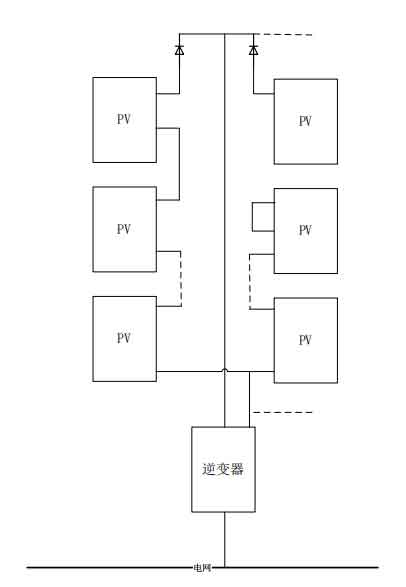
The centralized structure of solar photovoltaic grid connected system has the following advantages:
(1) The circuit topology is simple and requires fewer components.
(2) Only one grid connected inverter is used, resulting in high inverter efficiency.
However, due to its simple structure, the centralized solar photovoltaic grid connected system has the following drawbacks:
(1) Poor system architecture expansion and redundancy capability.
(2) The solar photovoltaic array cannot achieve efficient maximum power point tracking due to multiple sets of units being connected in series and parallel.
(3) Poor resistance to heat spots and shadows.
(4) Due to the presence of diodes, the system incurs significant additional losses.
(5) Due to the direct connection of solar photovoltaic arrays to inverters, higher DC voltage is required, and system safety cannot be guaranteed.
Due to the low unit power generation cost of the centralized grid connected system, this structure can still be used as the main power generation structure in power plants with higher power levels.
2. Communication modular structure
The AC modular grid connected system is a structure that combines solar photovoltaic arrays with grid connected inverters into a whole and is uniformly connected to the AC bus. It is generally used for solar photovoltaic power generation systems with a power level of less than 1kW, and its system structure is shown in Figure 3.
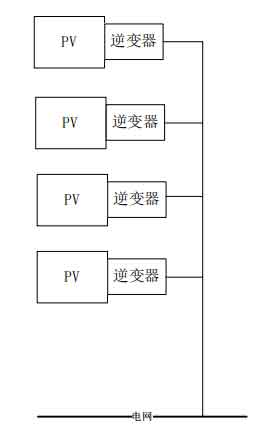
Due to the small capacity of each group of AC modular inverters, their inverters have three different topology structures, as shown in Figure 4.
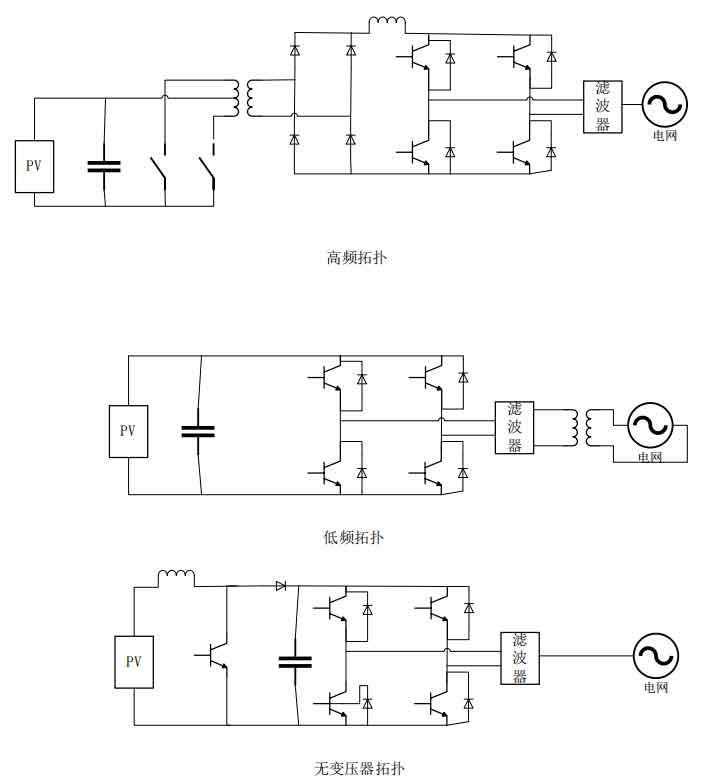
Compared with centralized structures, AC modular solar photovoltaic grid connected structures have the following advantages:
(1) Due to the fact that each solar photovoltaic array is equipped with a grid connected inverter, the system has strong scalability and redundancy capabilities.
(2) Each solar photovoltaic array independently performs maximum power point tracking, resulting in higher power generation efficiency of solar photovoltaic cells.
(3) Not affected by heat spots and shadows.
(4) The absence of diodes in the system structure reduces system losses.
(5) There is no high-voltage DC bus, replaced by AC bus, ensuring system safety.
However, the modular structure of communication also has the following drawbacks:
(1) Due to the need for grid connected inverters for each group of solar photovoltaic modules, the unit cost of power generation is high.
(2) And due to the low total power of each module, the inverter inverter efficiency is relatively low.
The modular structure of communication is widely used in BIPV systems due to its strong flexibility. However, due to the small capacity of each module, it is not as competitive in power generation cost as the centralized structure.
3. String structure
The string structure has both the modular form of AC modular structure and the characteristic of centralized access to solar photovoltaic arrays. It is composed of solar photovoltaic modules that are connected in series to increase the DC voltage to the required voltage of the inverter, and then form a solar photovoltaic array that is connected to the grid connected inverter and connected to the AC power grid. The system structure is shown in Figure 5.
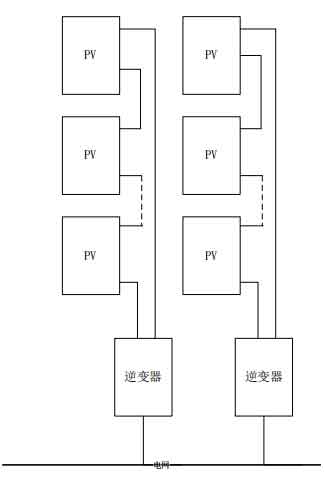
Compared to the above two structures, the string structure has the following advantages:
(1) Compared to centralized structures, it has increased flexibility and redundancy, but it is not as good as communication modular structures.
(2) Each group of series connected solar photovoltaic arrays is uniformly tracked for maximum power point, which improves the efficiency compared to centralized power generation, but is also inferior to AC modular power generation.
(3) The impact of hot spots and shadows has decreased, and only each string of solar photovoltaic modules is affected.
(4) The relatively centralized structure reduces one diode and reduces system losses.
(5) The solar photovoltaic modules are directly connected to the grid connected inverter through series connection, and there is no DC high-voltage bus, ensuring system safety.
In addition to system scalability, redundancy, and lower power generation efficiency compared to AC modular systems, there are also the following issues:
(1) The increase in system topology complexity has led to an increase in unit power generation costs.
(2) The capacity of a single series array is still relatively small, and the system capacity is not large.
The string structure has both the high efficiency characteristics of a centralized structure and the modular characteristics of an AC modular structure. Similarly, it falls between the two in terms of generation capacity, generation efficiency, system losses, and generation costs.
4. Multi branch structure
The multi branch structure is to convert the electrical energy emitted by solar photovoltaic modules into DC/DC and then connect them in series and parallel to meet the DC voltage and current requirements of the grid connected inverter. The main idea is divided into series multi branch structure and parallel multi branch structure. The system structure diagram is shown in Figure 6.
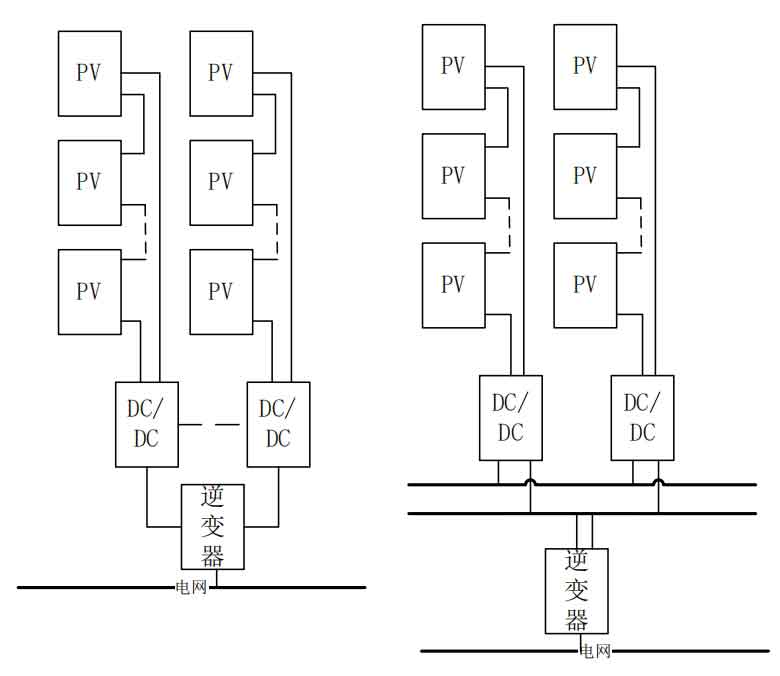
Considering the ease of implementation of system redundancy and power generation economy, solar photovoltaic grid connected systems with half bridge inverters and multi branch structures are commonly used in practical applications. The system circuit topology is shown in Figure 7.
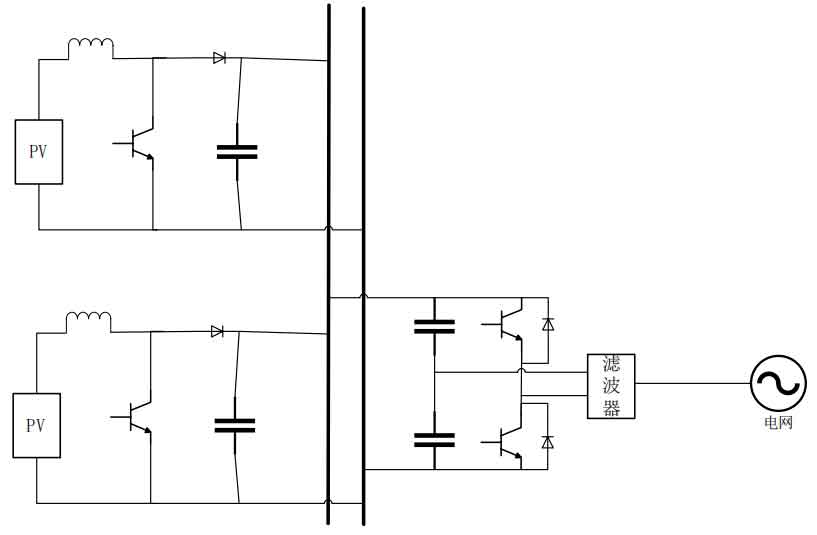
The multi branch structure has the following advantages:
(1) In the event of a module failure in a multi branch structure, the system can continue to operate by shielding a certain module. The system’s expansion flexibility and redundancy ability are comparable to those of an AC module.
(2) Each group of solar photovoltaic modules is independently tracked for maximum power point through a DC/DC converter, and is connected to a grid connected inverter through a DC bus, resulting in high system power generation efficiency.
(3) Similar to the modular structure of communication, it is not affected by heat spots or shadows.
(4) The multi branch structure has no specific requirements or limitations on the output characteristics of solar photovoltaic modules on each branch, and the power generation capacity is greatly improved compared to the series structure, making it suitable for the application of new high-power BIPV systems.
The multi branch structure combines the advantages of modular communication, easy scalability, strong redundancy, and solves the problem of centralized inability to accurately track maximum power points. Since the 1990s, it has gradually replaced various structures and become the mainstream trend.
5. Master-slave structure
With the development of science and technology, as well as the concept of Internet plus and the Internet of Things, a master-slave solar photovoltaic grid connection structure has emerged. It changes the circuit structure to adapt to the grid connection power generation strategy under different conditions through communication. It always aims at high efficiency. Through the combination of collaborative switches, it can generate power in a centralized and efficient manner, or generate power independently in an AC module distributed manner, When the light intensity is weak, a series structure can also be connected to the grid connected inverter. The circuit structure is extremely flexible, and its circuit topology is shown in Figure 8.
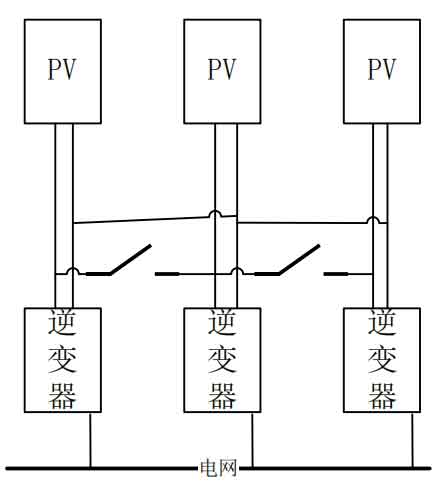
6. DC modular structure
Similar to the AC modular grid connected structure, each solar photovoltaic module is equipped with a set of DC/DC modules and the AC modular bus is changed to DC, which is then connected to the grid connected inverter. The system structure diagram is shown in Figure 9.
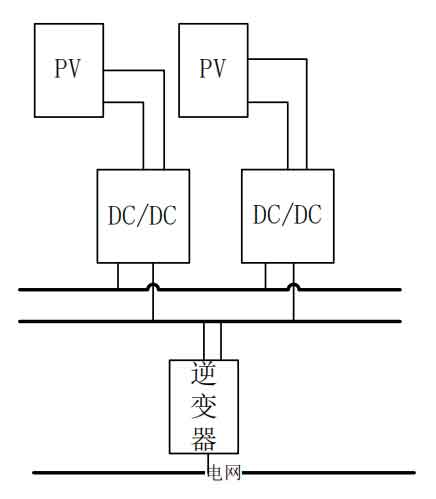
The DC modular structure has similar flexibility and expandable redundancy to the AC modular structure, and due to the independent maximum power point tracking of each solar photovoltaic module and the use of centralized grid connected inverters for grid connected power generation in a centralized structure, its power generation efficiency is also high. In recent years, its proportion in building solar photovoltaic power generation projects has been increasing.
For the study of grid connected systems with small scale and without considering other factors such as thermal spots, a centralized structure will be adopted as the structure of the solar photovoltaic grid connected system.
